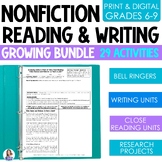Primary and Secondary Sources Activities - Informational Text and Showdown Game
- Zip
What educators are saying
Also included in
- Are you looking for a variety of middle school ELA nonfiction resources that contain engaging, rigorous, and differentiated materials? This non-fiction reading comprehension bundle contains 29 individual units and lessons, including close reading units, argumentative writing units, seasonal ELA bellPrice $89.99Original Price $136.88Save $46.89
Description
Introducing the concepts of primary and secondary sources to middle school students can be challenging. This primary and secondary sources activity is designed for teachers of English Language Arts or Social Studies in grades 5-8. The lesson focuses on helping students identify primary and secondary sources that are relevant to them. It includes an informational text that introduces students to the concepts of primary and secondary sources. Students will read and practice annotation skills while learning the basics. They will then participate in a game called "Primary and Secondary Sources Showdown" to test their new knowledge. Detailed answer keys have been provided for each example in the game, and there are options to customize the slides to better fit the needs of your students.
❤️ Why You'll Love This Resource:
✅ SAVE your TIME and ENERGY with this LOW PREP Resource
✅ Covers MULTIPLE ELA Standards and Skills
✅ Clear Student Directions and Answer Keys Included
✅ Student-Centered Activity: Let Your Students Do the Thinking!
✅ Print Resources
✍ What's Included:
• Primary and Secondary Sources Informational Text
• Primary and Secondary Sources Worksheet
• 7 Examples of Primary and Secondary Sources
• Primary vs. Secondary Sources Game Worksheet
• Showdown Signs
• Self Reflection
• Primary and Secondary Sources Powerpoint Presentation:
What Other Teachers Are Saying About This Resource:
⭐⭐⭐⭐⭐: Taylor T. says, "Wonderful resource! Helped my students understand the difference between primary and secondary sources. Also really helped them with using evidence and explaining why.”
⭐⭐⭐⭐⭐: Melissa M says, “Excellent resource to reinforce primary vs secondary sources! I have been using it for a while now and my students are always engaged.”
⭐⭐⭐⭐⭐: Cynthia S. says, “Exactly what I was looking for to introduce primary and secondary sources to my sixth grade Social Studies students. Great for hitting those Common Core Standards! Thank you!”
⭐⭐⭐⭐⭐: Nicole S. says, “FANTASTIC. I could not have gotten through my primary and secondary source without this.”
Please be sure to download the preview file to see exactly what you are getting when you purchase this product!
Created by Stephanie M. Icenogle, The Creative Classroom © 2013; updated © 2022
All rights reserved by author.
Permission to copy for single classroom use only.
Electronic distribution limited to single classroom use only.






